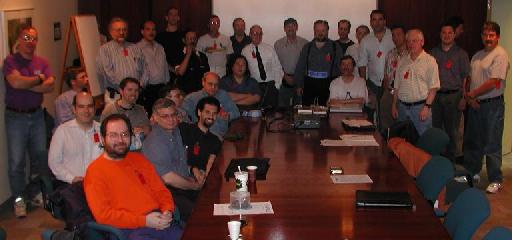| |
Home | About | Mailing Lists | Meetings | Newsletter | FTP | Locate File | |
Please note our new meeting location: The IBM offices, at 400 Ellice Ave. (between Edmonton and Kennedy). When you arrive, you will have to sign in at the reception desk, and then wait for someone to take you (in groups) to the meeting room. Please try to arrive by about 7:15 PM, so the meeting can start promptly at 7:30 PM. Don't be late, or you may not get in.
Limited parking is available for free on the street, or in a lot across Ellice from IBM, for $1.00 for the evening. Indoor parking is also available nearby, at Portage Place, for $2.00 for the evening.
Also, don't forget about our MUUG t-shirt promotion, being coordinated by Shawn Wallbridge. If you're interested in a shirt, or in submitting a design suggestion, now's the time to respond.
ucd-snmp package,
so that MRTG can get interface statistics from it,
plus many tips on how to secure that setup.
Finally, an example was shown of using MRTG to display CPU usage stats.
The meeting also included a longer-than-usual round-table discussion, plus some preliminary discussion on the proposed by-law amendments and the call for nominations for the MUUG board.
The meeting also included our usual round-table discussion, plus the vote on the by-law amendments and the election by acclamation of the new MUUG board of directors. A big welcome to our new board members, Adam Thompson, Sean Walberg, and Shawn Wallbridge, and a big "thank you" to our returning board members, Gilbert Detillieux, Kevin McGregor, and Doug Shewfelt!
More specifically, he covered the init process,
the /etc/inittab file,
the various run-level rc scripts,
the service-specific scripts in /etc/init.d,
and the network services started through inetd or
xinetd.
Some (system-specific) tools for enabling and disabling services were also
shown, such as chkconfig, tksysv, and
ntsysv.
Networking through your power outlets: After the usual round-table discussion, Bill Reid did a short "show and tell" presentation on two products. One was an enclosure for a 2 inch (laptop type) IDE disk drive, which lets you use it as a portable drive that interfaces (and draws its power) via USB. The other was an Ethernet to power line bridge.
Most homes have multiple power outlets in every room, and power outlets are all connected together through the electrical wiring already installed in the home. Since HomePlug technology allows the power outlets to do "double duty" as both a power source and a network port, products can implement this technology at a lower cost. Also, the convenience of connecting any device through a power outlet will enable exciting new products covering entertainment, information access and telephony services.
More information on the technology is available from The HomePlug Powerline Alliance. A Canadian company that manufactures a HomePlug chip is Cogency. A Canadian seller of HomePlug products is NCIX.com (search for powerline).
In this presentation, Shawn Wallbridge briefly covered the install, how the Portage system works and other neat things about this distribution.
The round-table discussion included, among other things, Shawn bouncing around the idea of having an additional monthly meeting dedicated to round-table discussions. This would not take anything away from the regular monthly meetings, but would allow members an additional opportunity each month to meet and share ideas and information. Shawn has volunteered to act as moderator for these meetings. If you're interested, be sure to sign up to the roundtable mailing list, if you haven't already, and join the online discussion. Be sure to let Shawn know you're interested in participating, and watch the list for details on where and when the meetings might occur.
Bill Reid presented this month's topic.
Brad Bollenbach introduced us to this "other language that begins with P" and showed how it can make your life easier, your code simpler, and how other people are putting the language to interesting use.
Brad has provided us with the slides to his presentation.
This version has many enhancements to the 2.x versions, including Active Directory support (this release is able to join a ADS realm as a member server and authenticate users using LDAP/Kerberos), Unicode support, better Windows 2000 printing support including publishing printer attributes in Active Directory, support for migrating from a Windows NT 4.0 domain, support for establishing trust relationships with Windows NT 4.0 domain controllers, and lots of other changes!
Kevin McGregor showed us how to get started in testing this leading-edge technology.
Adam Thompson was our presenter for this month. Three types of clustering were discussed (Failover, LVS, and Beowulf) and some typical examples of each were presented.
And, as we did last year (this may become a tradition), we ended off the year with a group photo...

"Say FREE!" (Photo courtesy of John Donovan)
Please note our new meeting location: The IBM offices, at 400 Ellice Ave. (between Edmonton and Kennedy). When you arrive, you will have to sign in at the reception desk, and then wait for someone to take you (in groups) to the meeting room. Please try to arrive by about 7:15 PM, so the meeting can start promptly at 7:30 PM. Don't be late, or you may not get in.
Limited parking is available for free on the street, or in a lot across Ellice from IBM, for $1.00 for the evening. Indoor parking is also available nearby, at Portage Place, for $2.00 for the evening.